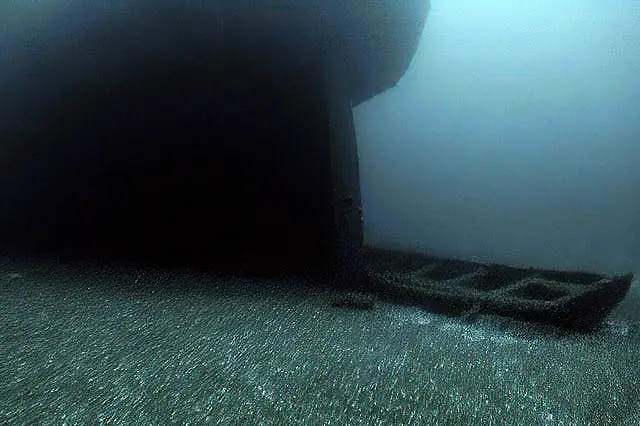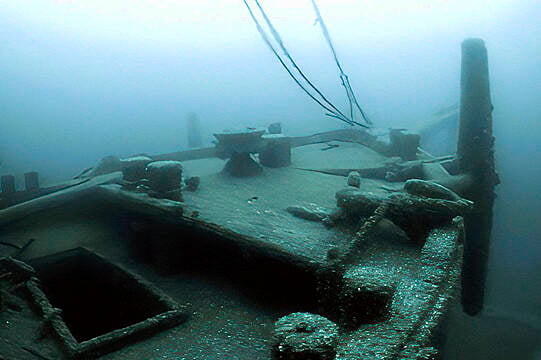Searchers have found a long-lost Great Lakes ship that came to a tragic end.
Officials with the Thunder Bay National Marine Sanctuary in Alpena, Michigan, say they have located the Ironton, a freight schooner that plunged to the bottom of Lake Huron in 1894.
The 191-foot (58-metre) cargo vessel collided with a grain hauler on a blustery night in September 1894, sinking both.
The Ironton’s captain and six sailors clambered into a lifeboat but it was dragged to the bottom before they could detach it from the ship. Only two crewmen survived.

The gravesite long eluded shipwreck hunters.
Now, the mystery has been solved, officials with Thunder Bay National Marine Sanctuary in Alpena, Michigan, said on Wednesday.
A team of historians, underwater archaeologists and technicians located the wreckage in 2019 and deployed remotely controlled cameras to scan and document it, Superintendent Jeff Gray told AP.
The sanctuary plans to reveal the location in coming months and is considering placing a mooring buoy at the site. Officials have kept the find secret to prevent divers from disturbing the site before video and photo documentation is finished.
Video footage shows the Ironton sitting upright on the lake bottom, hundreds of feet down — “remarkably preserved” by the cold, fresh water like many other Great Lakes shipwrecks, Mr Gray said.
No human remains were seen. But the lifeboat remains tethered to the bigger vessel, a poignant confirmation of witness accounts from 128 years ago.
“Archaeologists study things to learn about the past. But it’s not really things that we’re studying, it’s people,” Mr Gray said. “And that lifeboat … really connects you to the site and reminds you of how powerful the lakes are and what it must have been like to work on them and lose people on them.”
The search and inspections involved a number of organisations, including Ocean Exploration Trust, founded by Robert Ballard, who located the sunken wreckage of the Titanic and the German battleship Bismarck.
“We hope this discovery helps contribute to an element of closure to the extended families of those lost on the Ironton, and the communities impacted by its loss,” Mr Ballard said. “The Ironton is yet another piece of the puzzle of Alpena’s fascinating place in America’s history of trade,” while the Thunder Bay sanctuary “continues to reveal lost chapters of maritime history”.
Nearly 200 shipwrecks are believed to rest within or nearby the boundaries of the sanctuary, which includes the Great Lakes Maritime Heritage Centre in Alpena and some 4,300 square miles of northwestern Lake Huron.
Several factors made the area a “shipwreck alley” for more than two centuries, until modern navigation and weather forecasting reduced the danger, said Stephanie Gandulla, the sanctuary’s resource protection coordinator.
The late 1800s was a busy period for Great Lakes commerce. Thousands of schooners, or sailing ships, and hundreds of steamers hauled cargo and passengers between bustling port cities such as Chicago, Detroit and Cleveland.
Vessels cruised to and from Lake Huron and Lake Michigan through the nearby Straits of Mackinac. Others ranged northward to Lake Superior, fetching iron ore for steel mills from mines in Minnesota and Michigan’s Upper Peninsula.
“It’s where the upbound and downbound shipping kind of crossed each other,” Mr Gray said. “Busy intersections are where most accidents happen.”
On the fateful night, the Ironton and another schooner barge, the Moonlight, were being towed northward from the Lake Erie town of Ashtabula, Ohio, by a steam-powered ship. They were bound for Marquette, a port city on Lake Superior.
The steamer broke down in heavy Lake Huron seas around 12.30am on the morning of September 26. The Ironton and the Moonlight disconnected their tow lines and drifted apart, with the Ironton crew setting sails and firing up its engine. It veered off course and ran into the Ohio, a freighter loaded with 1,000 tons of flour, about 10 miles off Presque Isle, Michigan.
The Ohio soon foundered, its crew of 16 rescued by the Moonlight. The Ironton stayed afloat more than an hour before going down.
So fierce was the gale that it claimed yet another schooner, the William Home, farther west on Lake Michigan. Six of seven crew members died.

Staffers with the sanctuary, part of the National Oceanic and Atmospheric Administration, took a sonar survey in the area of the Ironton-Ohio collision in 2017. They detected two images on the lake bed, one later identified as the Ohio. The other was a more recent shipwreck.
It took two more years to track down the Ironton several miles away. Mr Ballard’s organisation provided an autonomous surface vehicle designed for seafloor mapping. After days of searching, it spotted a figure that later was confirmed as the Ironton.
A high-resolution scan in 2021 provided more details. The vessel is largely intact, Mr Gray said. Its masts point skyward, with rigging and ropes tied to spars and lying on deck. The robotic camera also showed the lifeboat tied to the ship’s stern.
The sanctuary awaits federal and state permits to plant the buoy.
“Then we get to share it with the rest of the world,” Mr Gray said, “and try to protect it so our grandkids can enjoy these sites the same way that we do today.”







